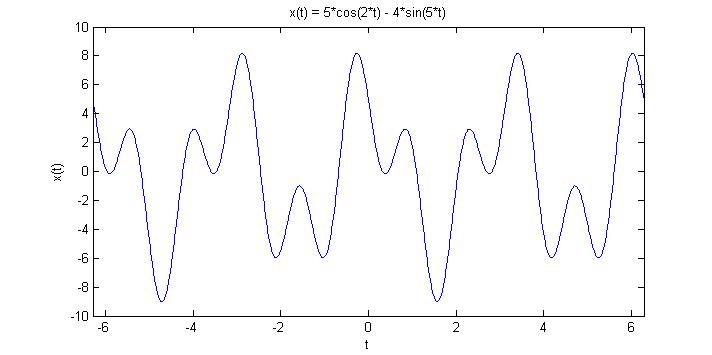(→Periodic CT Signal and Its Fourier Coefficients) |
(→Periodic CT Signal and Its Fourier Coefficients) |
||
| Line 8: | Line 8: | ||
<math> a_k = \frac{1}{T} \int_{0}^{T} x(t)* e</math><sup>(<math>-j*k*w_0*t</math>)</sup><math> \,\ dt</math> | <math> a_k = \frac{1}{T} \int_{0}^{T} x(t)* e</math><sup>(<math>-j*k*w_0*t</math>)</sup><math> \,\ dt</math> | ||
| + | If our signal <math> x(t) </math> consists of only sine and cosine waves, we don't have to do all those complicated integrals in order to find the Fourier coefficients <math> a_k </math>. | ||
| Line 31: | Line 32: | ||
The period <math> \,\ T = 2\pi </math> so if <math> \,\ w_0 = \frac{2\pi}{T} </math>, then <math> \,\ w_0 = 1 </math>. | The period <math> \,\ T = 2\pi </math> so if <math> \,\ w_0 = \frac{2\pi}{T} </math>, then <math> \,\ w_0 = 1 </math>. | ||
| + | |||
| + | Our new equation can now be rewritten as:<br> | ||
| + | |||
| + | <math> \,\ x(t) = \frac{5}{2} * e</math><sup>(<math>j*w_0*k_1*t</math>)</sup> <math> \,\ + \frac{5}{2} * e</math><sup>(<math>j*w_0*k_2*t</math>)</sup><math> - \frac{4}{5} * e</math><sup>(<math>j*w_0*k_3*t</math>)</sup> <math>+ \frac{4}{5} * e</math><sup>(<math>j*w_0*k_4*t</math>)</sup> | ||
Revision as of 14:10, 25 September 2008
Periodic CT Signal and Its Fourier Coefficients
A Fourier Series of a periodic CT signal is such that:
$ x(t) = \sum_{n=-\infty}^\infty a_k * e $($ j*k*w_0*t $)
where
$ a_k = \frac{1}{T} \int_{0}^{T} x(t)* e $($ -j*k*w_0*t $)$ \,\ dt $
If our signal $ x(t) $ consists of only sine and cosine waves, we don't have to do all those complicated integrals in order to find the Fourier coefficients $ a_k $.
Take the signal $ x(t) = 5cos(2t) - 4sin(5t) $. The graph below proves that it is indeed periodic, with a period $ T = 2\pi $.
$ \,\ sin(x) = \frac{1}{2j} * (e $(jx) $ \,\ - e $(-jx)$ \,\ ) $
and
$ \,\ cos(x) = \frac{1}{2} * (e $(jx) $ \,\ + e $(-jx)$ \,\ ) $
Therefore,
$ x(t) = 5 * \frac{1}{2} * (e $(j2t) $ \,\ + e $(-j2t)$ \,\ ) - 4 * \frac{1}{5j} * (e $(j5t) $ \,\ - e $(-j5t)$ \,\ ) $
$ \,\ x(t) = \frac{5}{2} * e $(j2t) $ \,\ + \frac{5}{2} * e $(-j2t)$ - \frac{4}{5} * e $(j5t) $ + \frac{4}{5} * e $(-j5t)
The period $ \,\ T = 2\pi $ so if $ \,\ w_0 = \frac{2\pi}{T} $, then $ \,\ w_0 = 1 $.
Our new equation can now be rewritten as:
$ \,\ x(t) = \frac{5}{2} * e $($ j*w_0*k_1*t $) $ \,\ + \frac{5}{2} * e $($ j*w_0*k_2*t $)$ - \frac{4}{5} * e $($ j*w_0*k_3*t $) $ + \frac{4}{5} * e $($ j*w_0*k_4*t $)


